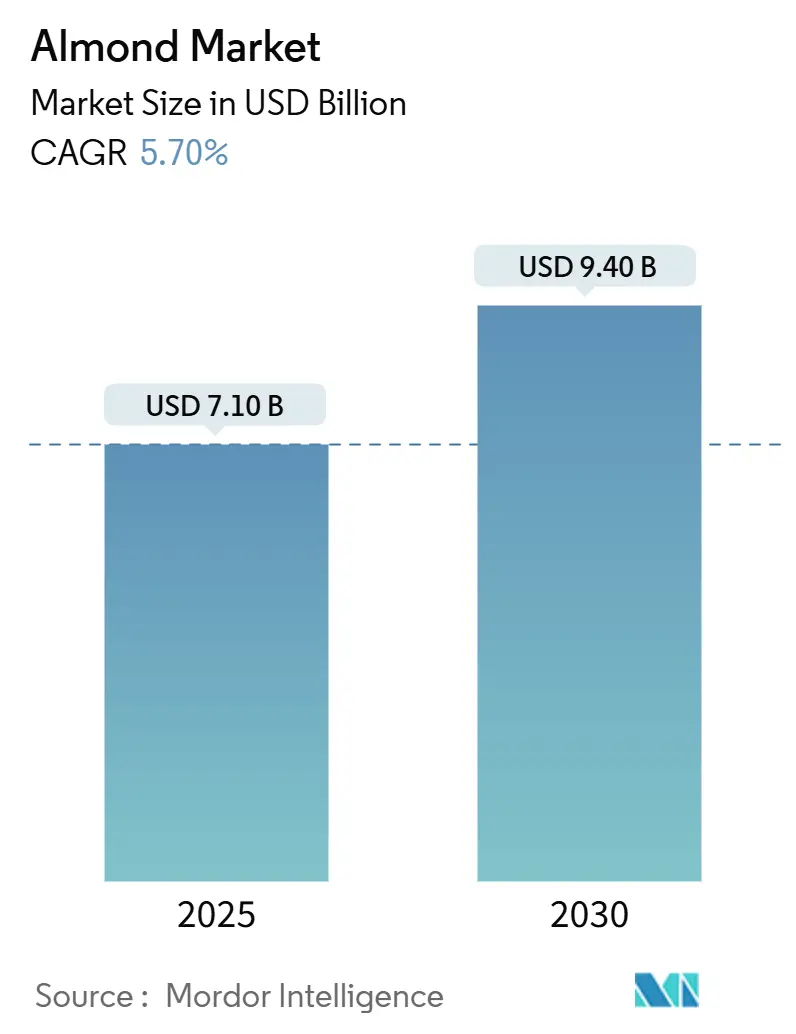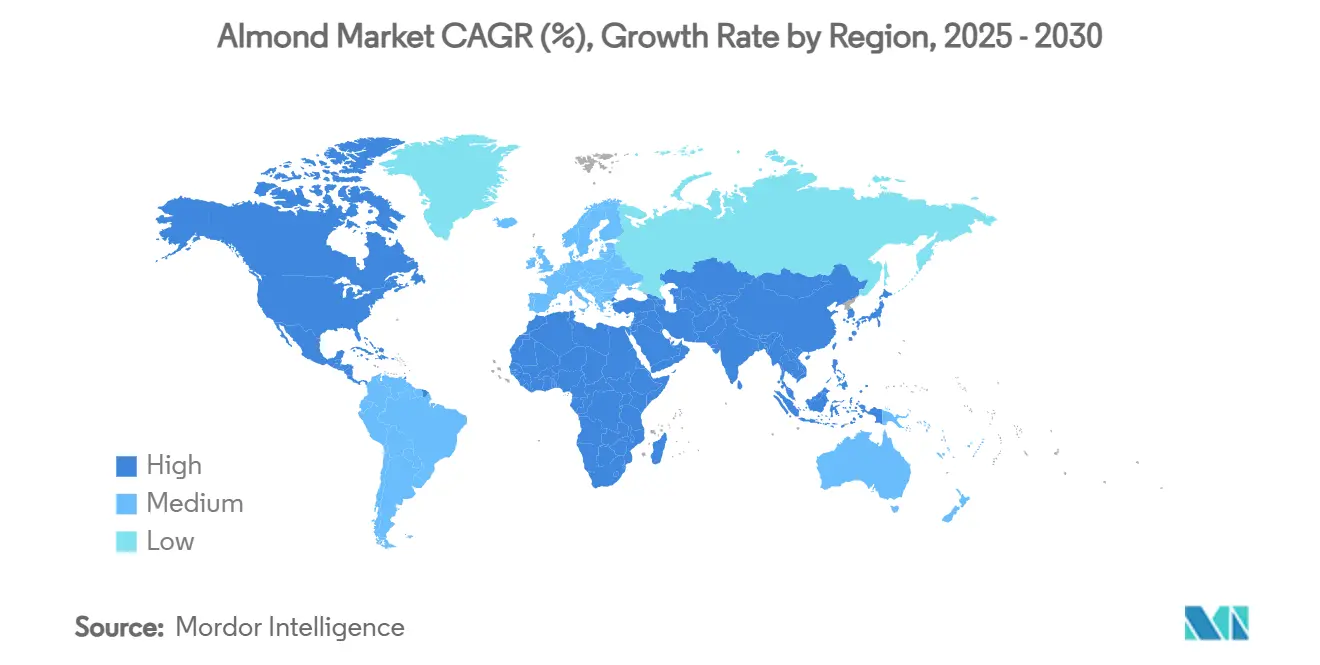Almond Market Size and Share

Almond Market Analysis by Mordor Intelligence
The almond market generated USD 7.1 billion in 2025 and is forecast to reach USD 9.4 billion by 2030, reflecting a 5.70% CAGR over the period. Growing consumer preference for nutrient-dense snacks, the rapid scale-up of almond-based dairy alternatives, and sustained investment in mechanised orchards underpin this expansion. California’s entrenched production base continues to shape global trade flows, even as water constraints accelerate varietal innovation and prompt acreage rationalization. Australia’s export-oriented growth, coupled with Asia-Pacific’s rising disposable income, is reshaping purchasing patterns toward premium and functional formats. Meanwhile, processors deploy AI-enabled grading systems and precision irrigation platforms to contain input costs and secure quality consistency, reinforcing price resilience despite cyclical oversupply pressure.
Key Report Takeaways
- By geography, North America dominated with 32.40% revenue share in 2024, whereas Asia-Pacific is set to expand at a 6.20% CAGR during the forecast horizon.
Global Almond Market Trends and Insights
Drivers Impact Analysis
| Driver | (~) % Impact on CAGR Forecast | Geographic Relevance | Impact Timeline |
|---|---|---|---|
| Adoption of drought-resistant almond cultivars | +1.2% | Global, with early gains in California, Australia, Spain | Medium term (2-4 years) |
| Expansion of mechanized orchards | +0.8% | North America and Europe, the Asia-Pacific core | Short term (≤ 2 years) |
| Rising demand from the plant-based dairy and confectionery industries | +1.5% | Global | Short term (≤ 2 years) |
| Surge in almond-based protein for sports nutrition | +0.9% | North America, Europe, urban Asia-Pacific | Medium term (2-4 years) |
| Government subsidies for nut cultivation | +0.6% | National, with early gains in California, Australia, Spain | Long term (≥ 4 years) |
| Precision irrigation and soil-moisture analytics reduce input costs | +1.1% | Global, spill-over to water-stressed regions | Medium term (2-4 years) |
| Source: Mordor Intelligence | |||
Adoption of Drought-Resistant Almond Cultivars
Global breeding programs introduce water-efficient varieties such as Spain’s self-compatible ‘Florida’ and ‘Alaska’ that reduce irrigation demand by 30% while protecting kernel size. California’s FruitionOne, slated for 2027 launch, removes cross-pollination requirements and lowers bee dependency by 40%, an advantage for producers facing volatile pollination costs[1]Source: HortScience Editorial Board, “Self-Compatible Almond Cultivars Reduce Water Needs,” ashs.org. Commercial rollout of these cultivars underpins long-term acreage optimization, encouraging growers to reinvest despite stricter groundwater regulations.
Rising Demand from Plant-Based Dairy and Confectionery Industries
Almond milk maintains category leadership as the global dairy alternative sector grows at 11.22% CAGR. Processors respond with higher-protein ingredients; Blue Diamond’s 50% protein almond powder now targets bar and smoothie manufacturers seeking short-label fortification. European chocolatiers specify almond coatings to differentiate texture and nutritive profile, catalysing 8.20% CAGR growth in this sub-segment. These developments collectively deepen ingredient penetration across beverage, confectionery, and on-the-go formats, sustaining volume growth even in mature consuming regions.
Expansion of Mechanized Orchards
Growers accelerate the adoption of autonomous harvesting and sorting platforms that trim labor requirements by 35% while boosting operational safety. FarmX’s GPS-independent retrofit solutions integrate seamlessly with existing tractors, enabling 24/7 orchard coverage regardless of canopy density. AI-equipped harvesters now process 1,000 kg per hour with 96% kernel-integrity accuracy, reducing field time and post-harvest losses[2]Source: TOMRA Food Division, “X-Ray Sorting Technology for Aflatoxin Control,” tomra.com. Drones, soil sensors, and automated irrigation scheduling combine to secure 20% yield gains in early pilot programs, creating a virtuous cycle of data-driven orchard stewardship.
Surge in Almond-Based Protein for Sports Nutrition
Sports-nutrition formulators gravitate toward nut-sourced proteins that provide neutral flavor, natural emulsification, and non-GMO positioning. Almond isolates deliver a complete amino-acid profile comparable to dairy counterparts, appealing to vegan athletes and flexitarian consumers. North American beverage startups blend almond protein with oat or pea bases, delivering ready-to-drink formats that register double-digit sell-through rates in specialty channels.
Restraints Impact Analysis
| Restraint | (~) % Impact on CAGR Forecast | Geographic Relevance | Impact Timeline |
|---|---|---|---|
| Water scarcity and irrigation caps | -1.8% | California, Australia, Mediterranean regions | Short term (≤ 2 years) |
| Volatile farm-gate prices from oversupply cycles | -1.2% | Global, with a concentration in major producing regions | Medium term (2-4 years) |
| Phytosanitary barriers and aflatoxin alerts in import checks | -0.9% | Global trade corridors | Medium term (2-4 years) |
| Rising labor costs and picker shortages in key producing regions | -1.4% | California, Australia, Spain | Short term (≤ 2 years) |
| Source: Mordor Intelligence | |||
Water Scarcity and Irrigation Caps
California’s Sustainable Groundwater Management Act is projected to remove 15% of current almond acreage from production, forcing some growers to fallow marginal blocks. Research from UC Davis shows that micro-irrigation combined with analytics can reduce consumption by one-third while preserving 95% of optimal yield, but capital expense remains a barrier for smallholders[3]Source: Institute for Youth in Policy, iyop.org. These dynamics tighten supply elasticity and heighten production risk during prolonged drought cycles.
Volatile Farm-Gate Prices from Oversupply Cycles
Global almond output rose 16.1% in the 2024-25 season, expanding inventories and dragging farm-gate prices. California’s receipts fell 35.3% year-on-year in December 2024, hinting shortfall versus early forecasts, yet still insufficient to clear carry-over stocks. Analysts expect 12–18 months of heightened volatility before demand absorbs surplus and prices stabilize above the USD 2.00 threshold, underscoring the sector’s exposure to rapid acreage expansion.
Geography Analysis
North America commanded 32.40% of global revenue in 2024, anchored by strong domestic demand, integrated processing infrastructure, and logistical proximity to California’s orchards. Canada’s imports rose 12% as retailers expanded private-label nut assortments to capture health-conscious shoppers. Supply-chain consolidation among cooperatives is projected to fortify cost leadership, sustaining competitiveness against lower-cost origins.
Asia-Pacific records the fastest 6.20% CAGR through 2030, propelled by China’s expanding middle-income cohort and India’s status as the largest importer in 2023. Tariff concessions under the Australia–China Free Trade Agreement elevate Australia’s origin share within China's import basket, while Vietnamese demand grows 15% annually on the back of rising urban incomes. These dynamics reorient trade lanes, with exporters tailoring kernel sizes, seasoning profiles, and value-added packaging to regional preferences.
Europe exhibits mature yet steadily rising consumption driven by Mediterranean diet advocacy and premium patisserie demand. Spain’s 32.6% rise in 2023 underscores renewed domestic appetite. Italy’s production rebound aids regional self-sufficiency, while Portugal and Greece leverage tourism recovery to amplify almond-based dessert offerings. Sustained marketing campaigns and origin certification programs are projected to consolidate consumer trust and support incremental growth across established European markets.

Recent Industry Developments
- June 2025: Blue Diamond Growers announced closure of its Sacramento facility, shifting production to Turlock and Salida to streamline operations and cut costs.
- May 2025: California industry forecasted a 2.8-billion-pound crop for 2025, signaling a potential rebound after three years of contraction.
- October 2024: Treehouse California Almonds and Sitos Group invested USD 9 million in a slow-pyrolysis biochar plant to valorise orchard by-products.
Research Methodology Framework and Report Scope
Market Definitions and Key Coverage
Our study defines the global almond market as the trade value of raw, sweet almonds, whether in-shell or shelled, sold at the first wholesale hand-off from growers or processors to food, snack, or ingredient buyers.
Scope exclusion: We leave out downstream derivatives such as almond milk, butter, flour, oil, bitter varieties grown for flavor extraction, and any nut blends.
Segmentation Overview
- By Geography
- North America
- United States
- Canada
- Europe
- Spain
- Italy
- Portugal
- Greece
- Asia-Pacific
- Iran
- Australia
- China
- India
- Vietnam
- South America
- Chile
- Argentina
- Middle East
- Saudi Arabia
- Egypt
- Africa
- Morocco
- Tunisia
- North America
Detailed Research Methodology and Data Validation
Primary Research
Mordor analysts interviewed orchard owners in California and Spain, Asian importers, and European ingredient buyers. The calls clarified contract ASPs, planned replanting, and consumption shifts toward snack packs, letting us adjust desk assumptions and cross-verify shipment volumes.
Desk Research
We began with public datasets that frame supply: USDA-NASS crop reports, Almond Board of California Almanac, FAOSTAT harvest and yield time-series, UN Comtrade customs codes 0802, and International Nut & Dried Fruit Council shipment dashboards. Our team also pulled trade-lane micro-data from Volza, company filings via D&B Hoovers, and press flow on Dow Jones Factiva to spot capacity changes and price swings.
These sources anchor acreage trends, producer margins, export premiums, and retail spreads; however, many others were reviewed to round out pricing, policy, and weather impacts.
Market-Sizing & Forecasting
A top-down harvest-to-value construct links global acreage, weighted yield, shell-out ratio, and average farmgate price, which are then indexed to trade and domestic utilization shares. Supplier roll-ups and channel checks act as a selective bottom-up sense check. Variables such as bearing acreage, non-pareil premium, export share to Asia, per-capita nut intake, and water-use rules feed a multivariate regression with an ARIMA overlay to project demand through 2030. Gaps in country-level data are bridged with peer-country analogs that primary experts endorsed before final sign-off.
Data Validation & Update Cycle
Outputs pass variance scans against historical shocks, price elasticity bands, and independent shipment benchmarks. Another analyst reviews anomalies, and reports refresh yearly, with mid-cycle updates if droughts, tariff moves, or major crop failures arise.
Why Mordor's Almond Baseline Numbers Give Buyers Reliable Confidence
Published almond values often differ.
Divergence usually traces to how firms bundle derivatives, convert currencies, or freeze price years.
Benchmark comparison
| Market Size | Anonymized source | Primary gap driver |
|---|---|---|
| USD 7.10 B (2025) | Mordor Intelligence | - |
| USD 9.92 B (2024) | Regional Consultancy A | Includes almond ingredients and derivative foods, widening scope |
| USD 8.61 B (2025) | Trade Journal B | Uses production value only, omits Asia retail demand |
| USD 8.23 B (2024) | Global Consultancy C | Applies top-down data with 2020 constant prices and no supplier checks |
The comparison shows that once scope creep and outdated pricing are stripped away, Mordor's balanced, variable-linked baseline emerges as the most transparent and repeatable yardstick for strategic planning.
Key Questions Answered in the Report
What is the current size of the almond market and how fast is it growing?
The almond market is valued at USD 7.1 billion in 2025 and is projected to reach USD 9.4 billion by 2030, expanding at a 5.70% CAGR.
Which region is projected to register the fastest almond demand growth?
Asia-Pacific leads with a 6.20% CAGR through 2030, propelled by rising consumption in China, India and emerging Southeast Asian economies.
What are the main factors driving global almond demand?
Rising popularity of nutrient-dense snacks, rapid uptake of almond-based dairy alternatives and confectionery coatings, and wider sports-nutrition use underpin consumption growth.
What is the most pressing production challenge for almond growers?
Water scarcity is the critical constraint, with regulations such as California’s Sustainable Groundwater Management Act threatening up to 15% of current acreage and raising irrigation costs in other producing regions.
Who is the largest almond producer in the world?
California maintains global leadership, accounting for about 82% of worldwide production and generating more than USD 6 billion in annual revenue.
How is technology improving efficiency in almond farming and processing?
Autonomous harvesting equipment, AI-powered sorting systems and precision irrigation platforms are cutting labor needs by up to 35%, improving quality control and reducing water use by roughly one-third.
Page last updated on:


